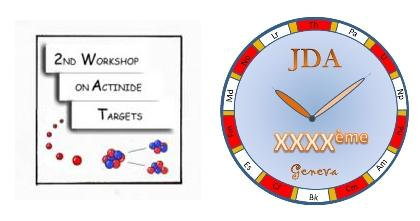Speaker
Dr
Ondrej Benes
(EC-JRC-ITU)
Description
The Molten Salt Reactor (MSR) is one of the six reactor concepts of the Generation IV (GenIV) initiative. In this concept the fissile material (233U, 235U and 239Pu) is dissolved in the molten fluoride matrix circulating in the primary circuit from the reactor core to the heat exchanger and back. Compared to solid fuel reactors, the advantage of the MSR is the possibility of fuel purification during the operation. Since the salt is in the liquid form it can be extracted, either online or in batches, and cleaned from the fission products in chemical re-processing plant. This process increases the effectiveness of the reactor because most of the fission products cause parasitic neutron capture and their accumulation would slow down the chain reaction.
Currently there are two main approaches of the MSR. The first are moderated and non-moderated breeder reactors based on the 232Th/233U cycle, for which respectively 7LiF–BeF2 and 7LiF are considered as an ideal matrix due to the very low parasitic neutron capture cross section of given cations. When designed as an actinide burner the fuel will be most likely PuF3 with possibly small addition of minor actinide tri- or tetra-fluorides (AmF3, NpF4, …). To achieve a favourable melting temperature of the fuel, the matrix based on the 7LiF–NaF–BeF2 system is the prime candidate.
In this study we perform a thermodynamic investigation of the LiF-NaF-UF4-ThF4 system in order to optimize the fuel composition of the molten salt fast reactor (MSFR) concept [1]. First the binary sub-systems are assessed based on the available experimental data and based on these results the higher order systems are extrapolated according to the developed mathematical formalisms. This approach was shown as a very strong tool of predicting the fuel behaviour as demonstrated in previous studies [2,3,4]. Furthermore once the thermodynamic database is developed properties such as melting temperature, vapour pressure or solubility of actinide fluorides in the fuel matrix can be calculated. All of these properties are very important quantities for the nuclear reactor design; hence the knowledge of the thermodynamic database is of importance.
The initial matrix of the molten salt fast reactor is based only on the pure 7LiF compound, however as shown in this study the melting temperature of the fuel based only on a single component solvent is rather high, around 840 K. This is also the main reason that the designed inlet temperature of this reactor concept is set relatively high at 903 K. One of the possible solutions to decrease the melting temperature of the fuel is to add another matrix component. Therefore one of the objectives of this work was to investigate the effect of the NaF addition as another possible component in the fuel solvent. It has been found that such addition has significant influence on the melting behaviour decreasing the melting point of the fuel by more than 50 K. This is reported in Figure 1 which shows a liquidus projection of the LiF-NaF-ThF4 pseudoternary system with a concentration of UF4 fixed at 2 mol% which corresponds to the initial concentration of this fissile material in the MSFR. The calculated lowest melting temperature was found at 772.6 K and ThF4 concentration of 22 mol%. This value is in agreement with the proposed concentration of this fertile material in the MSFR.
Author
Dr
Ondrej Benes
(EC-JRC-ITU)
Co-authors
Mr
Marcus Beilmann
(EC-JRC-ITU)
Dr
Rudy Konings
(EC_JRC_ITU)
